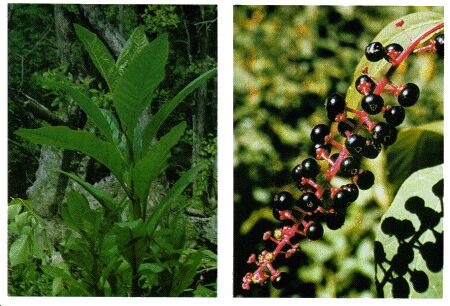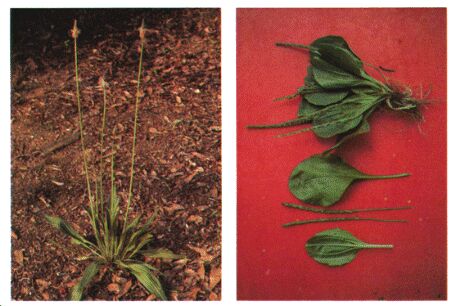Plantain, broad and narrow leaf
Plantago species
Description: The broad leaf plantain has leaves over 2.5 centimeters
across that grow close to the ground. The flowers are on a spike that rises from the middle of the
cluster of leaves. The narrow leaf plantain has leaves up to 12 centimeters long and 2.5 centimeters
wide, covered with hairs. The leaves form a rosette. The flowers are small and inconspicuous.
Habitat and Distribution: Look for these plants in lawns and along roads
in the North Temperate Zone. This plant is a common weed throughout much of the world.
Edible Parts: The young tender leaves are edible raw. Older leaves should
be cooked. Seeds are edible raw or roasted.
Other Uses: To relieve pain from wounds and sores, wash and soak the
entire plant for a short time and apply it to the injured area. To treat diarrhea, drink tea made from
28 grams (1 ounce) of the plant leaves boiled in 0.5 liter of water. The seeds and seed husks act as
laxatives.

Pokeweed
Phytolacca americana
Description: This plant may grow as high as 3 meters. Its leaves are
elliptic and up to 1 meter in length. It produces many large clusters of purple fruits in late spring.
Habitat and Distribution: Look for this plant in open, sunny areas in
forest clearings, in fields, and along roadsides in eastern North America, Central America, and the
Caribbean.
Edible Parts: The young leaves and stems are edible cooked. Boil them
twice, discarding the water from the first boiling. The fruits are edible if cooked.
|
CAUTION
|
|
All parts of this plant are poisonous if eaten raw. Never eat the
underground portions of the plant as these contain the highest
concentrations of the poisons. Do not eat any plant over 25 centimeters
tall or when red is showing in the plant.
|
|
Other Uses: Use the juice of fresh berries as a dye.
| Updated:
12 January 2008 |
|
Born on 05 January 2000 |





